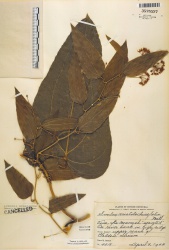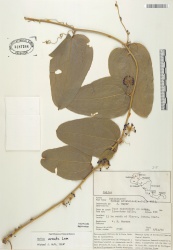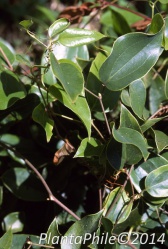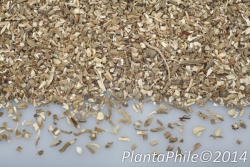|
AHPA recognizes other valuable resources exist regarding the identity of Smilax aristolochiifolia.
To submit a suggestion or contribution, please contact Merle Zimmermann.
|
Nomenclature
Smilax aristolochiifolia Mill. Smilacaceae
Syn. Smilax medica Schltdl. & Cham.; Smilax ornata Lem.
Standardized common name (English): sarsaparilla
Botanical Voucher Specimen
Organoleptic Characteristics
Macroscopic Characteristics
| S. medica has an angular stem, armed with straight prickles at the joints, and a few hooked ones in the intervals. The leaves are smooth, bright green on both sides, shortly acuminate, five-nerved, with the veins prominent beneath. They vary much in form, the lower being cordate auriculate-hastate, the upper cordate-ovate. In the old leaves the petiole and midrib are armed with straight subulate prickles. The inflorescence is an umbel of from eight to twelve flowers, with a smooth axillary peduncle and pedicels about three lines long.
The Mexican or Vera Cruz sarsaparilla is derived from this species. ... [The roots] consist of a head or caudex with numerous long radicles, which, however, are somewhat smaller than in that variety, and have a thinner bark. They are often also much coiled with earth. It contains but little starch and has quadrangular endodermal cells, with thickened walls, and more or less oval lumen.
Source: United States Dispensatory (1918) [3]
|
|
|
|
|
Microscopic Characteristics
| Under the microscope, transverse sections of all of the commercial varieties of Sarsaparilla show an epidermal layer with basal portions of root hairs; a hypodermis composed of several layers of strongly lignified cells, the walls being uniformly thickened, except in Mexican Sarsaparilla in which the inner walls are only slightly thickened; a cortex composed of numerous parenchyma cells mostly containing starch, some containing resin or raphides of calcium oxalate; an endodermis of a single layer of strongly lignified cells, the walls being' uniformly thickened except in Mexican Sarsaparilla in which the outer walls are only slightly thickened; a central cylinder composed of radial bundles connected with sclerenchymatous fibers, the tracheas being large and oval and the phloem in small groups at the periphery of the bundle; and a pith composed of starch-bearing parenchyma cells.
Powdered Sarsaparilla is light grayish-brown to dark grayish-brown; when examined under the microscope it exhibits numerous starch grains, from 0.003 to 0.023 mm. in diameter, spherical, or biconvex or spherical-tetrahedral, single to 2- to 4-compound, and frequently with a central-elliptical cleft; calcium oxalate in raphides, from 0.006 to 0.035 mm. in diameter, occurring singly or in groups; cells of the hypodermis and endodermis with lemon-yellow or reddish-yellow porous walls and, in the case of Mexican Sarsaparilla, showing an uneven or irregular thickening, the individual cells from 0.08 to 0.5 mm. in length; fragments of trachea) with simple and bordered pores or scalariform or reticulate thickenings associated with sclerenchymatous fibers having rather thin, very slightly lignified and porous walls.
Source: United States Dispensatory (1918) [6]
|
|
|
|
|
High Performance Thin Layer Chromatographic Identification
Supplementary Information
Sources
- ↑ MOBOT, Tropicos.org http://www.tropicos.org/Image/26042
- ↑ MOBOT, Tropicos.org http://www.tropicos.org/Image/27626
- ↑ United States Dispensatory (1918)
- ↑ PlantaPhile http://plantaphile.com/
- ↑ PlantaPhile http://plantaphile.com/
- ↑ United States Dispensatory (1918)



